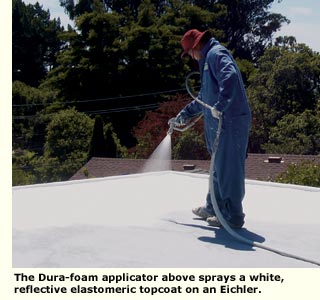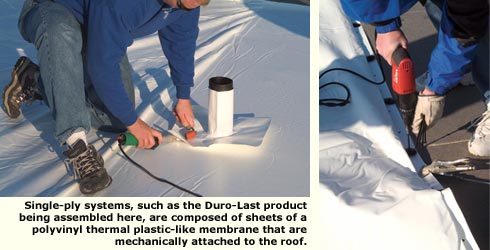Roofing Survival Guide - Page 3
A variation on the tar-and-gravel system is the mineral cap installation, which, instead of being topped with loose gravel, uses a material with small rocks embedded in it. "It's used more on commercial buildings," says Responsible Roofing's Eduardo Peña. "But it's really easy to clean, and you can use a blower to blow debris off the roof."
In the Long Beach area, the modern Cliff May Ranchos have their own special needs and expectations. Rochelle Kramer, a Rancho real estate specialist with Re/Max and RanchoStyle.com, says many Rancho homeowners in the 1970s and '80s tore off the original T&G roofs, which had built-in rain gutters, and replaced them with composition shingles and new gutters tacked onto the fascia.
"There were two problems with that," Kramer says. "One, it took away from the originality of the home to put on composition shingle—a rock roof is the appropriate style for the house. Two, rain gutters detract from the [look of the] roof. And three, we found that the insulation qualities of tar and gravel were better than the composition shingles."
Similar to Peña's mineral cap recommendation, white gravel or rock can be added to a Rancho's T&G to help reflect the sun, aid in energy savings, and ultimately reinforce the original aesthetic.

Sprayed Polyurethane Foam System
Rigid polyurethane-foam sheeting has been used for years as an insulator under tar-and-gravel roofs, as well as with other roofing types. But this material has also risen to prominence as a roofing option in its own right. Spray-on foam, while one of the more expensive roofing options, also offers distinct advantages. "The products are expensive, but it's a savings in labor [over other systems]," says Dura-foam's Randy Feriante.
Finding a quality installer is critical for foam roofs because they are manufactured on site. Foam roofing is delivered through a hose and sprayed on the roof as a liquid. The liquid rises as it cures. Once cured, several layers of elastomeric coating are applied. Elastomeric properties are important, since they allow the coating to stretch as the foam expands and contracts. A gray base coat serves to protect the roof from the UV rays of the sun, while a white topcoat adds reflectivity, making the roof more energy efficient.
Because of the way it is installed, foam can be applied over most existing roofs—another advantage. However, for roofs with multiple layers of old roofing material, it is recommended to remove some or all of the layers prior to re-roofing. "Our Eichler and Streng people really like foam roofs," says Rick Abril of Abril Roofing. "You can put on all the insulation you want in a roof, and the elastomeric topcoat is a good waterproofer and reflects the sun."
Foam roofs do need elastomeric re-coating, which should be done at least once during the life of the roof. While recommendations vary depending on the manufacturer, most recoat recommendations are between five and ten years after the initial installation.
Edgar Chuang recently replaced the tar-and-gravel roof on his 1,500-square-foot Redwood City Eichler. He says he considered it more environmentally friendly than other options he evaluated because his installer recycled the old gravel. He was also happy that he was able to re-roof right over the existing tar, which kept his roofer from dumping old tar in the landfill.
His advice to homeowners faced with a new roof? "Make sure they cover everything so that the overspray doesn't get on windows, fences, or the courtyard."
Single-Ply Systems
Single-ply systems are composed of sheets of a polyvinyl thermal plastic-like membrane that are mechanically attached to the roof. There are many single-ply manufacturers in the marketplace, and the most prominent in California are Duro-Last, Johns Manville, and IB Roof Systems.
"Single-ply roofing is a waterproof membrane that water can't get through," says John Rossi of Cal-Pac Roofing, who favors Duro-Last. Single-ply membranes are also successful for use as roofing materials because of their proven ability to withstand the ultraviolet rays of the sun.
The membranes are installed as approximately five-foot-wide sheets that are held together by the use of an adhesive. Insulation can also be installed underneath, if desired.
Since single plies are highly reflective, they reduce heat gain. While some homeowners opt for installation without additional insulation, others prefer it to gain cold-weather protection.

Modified Bitumen System




